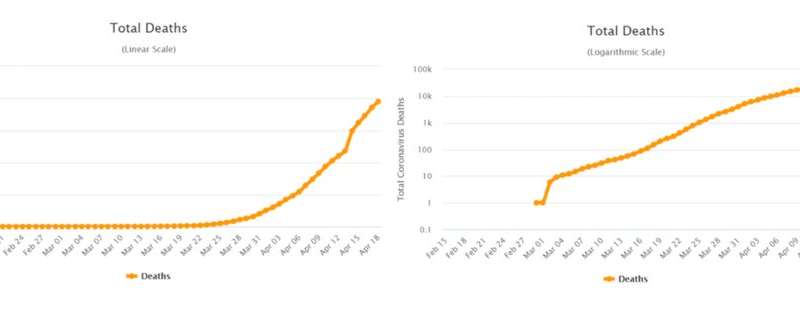COVID data is complex, changeable and difficult for the public to track in real time

Throughout the pandemic, public health decisions have been based on the government’s interpretation of data. With COVID restrictions lifting in England on Monday July 19, that onus will now fall primarily on the general public—and the news media that keeps them informed.
The success of this shift from government responsibility to public responsibility will be a fundamental factor in how successfully the UK plots its path out of the pandemic. And at its heart it’s a question of data literacy, or the ability of the public to understand and make informed decisions—about mask-wearing, self-isolation and home-working—based on the COVID data they’re exposed to.
As an expert in data literacy, I’ve watched as data has assumed a central role in determining the degree of society’s freedom since March 2020. Niche statistical jargon and data visualizations are now widespread in the public domain, with specialist data sites such as Johns Hopkins COVID-19 Map and the Worldometer’s coronavirus page receiving a surge of traffic.
But are English people really ready to digest the deluge of COVID data on their own? One study has already suggested that lockdown ending will result in the public taking COVID-19 less seriously. Coupled with the fact that COVID data is complex and subject to constant change as new variants emerge and spread, it’s unclear whether the general public is prepared to make informed, data-driven decisions after July 19.
Data indigestion
I find it tempting to celebrate the public’s expanding access to data and familiarity with terms like “flattening the curve”. After all, a better informed society is a successful society, and the provision of data-driven information to the public seems to contribute to the notion that together we can beat COVID.
But increased data visibility shouldn’t necessarily be interpreted as increased data literacy. For example, at the start of the pandemic it was found that the portrayal of COVID deaths in logarithmic graphs confused the public. Logarithmic graphs control for data that’s growing exponentially by using a scale which increases by a factor of ten on the y, or vertical axis. This led some people to radically underestimate the dramatic rise in COVID cases.
The vast amount of data we now have available doesn’t even guarantee consensus. In fact, instead of solving the problem, this data deluge can contribute to the polarization of public discourse. One study recently found that COVID skeptics use orthodox data presentation techniques to spread their controversial views, revealing how more data doesn’t necessarily result in better understanding. Though data is supposed to be objective and empirical, it has assumed a political, subjective hue during the pandemic.
These examples show that data literacy must accompany data availability in the coming weeks and months. Only a data-literate public can make decisions that keep everyone as safe as possible. And empowering the public with this competency is in turn the responsibility of journalists and educators.

Making sense of information
Journalists are vital conduits between the scientific community and the general public. Data journalism in particular, a relatively small subset of journalism before the pandemic, has been essential in communicating how the scientists who inform governments reached their decisions.
Yet data journalists themselves may not be as data literate as the scientific community. Attempts by journalists to portray accurate accounts of the COVID situation are not always successful. Countries hit early by the pandemic, such as Italy, were also the first to reveal the limitations of data journalism, and have since provided valuable reports on the lessons they learned. In 2019, there were only 20 data journalists in the whole of Italy.
This is where educators come in. The pandemic has only strengthened the case presented by academics for data literacy to be included in the curriculum at all educational levels, including primary. This could help citizens navigate our data-driven world, protecting them from harmful misinformation and journalistic malpractice.
Data literacy does in fact already feature in many higher education roadmaps in the UK, though I’d argue it’s a skill the entire population should be equipped with from an early age. Misconceptions about vaccine efficacy and the severity of the coronavirus are often based on poorly presented, false or misinterpreted data. The “fake news” these misconceptions generate would spread less ferociously in a world of data literate citizens.
To tackle misinformation derived from the current data deluge, the European Commission has funded projects such as MediaFutures and YourDataStories. Media Futures aims to reshape how the media uses data, while YourDataStories aims to develop tools to bring data-driven information suppliers closer to journalists, with a focus on open data. The Commission also funds data literacy education across the EU, indicating how seriously public authorities are now taking data literacy.
Source: Read Full Article
